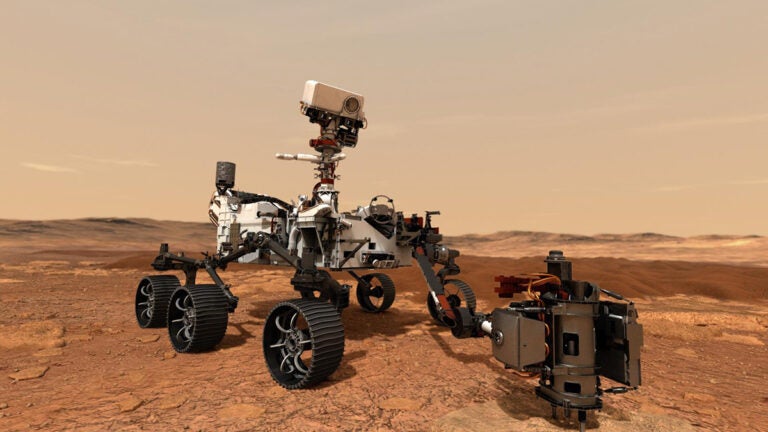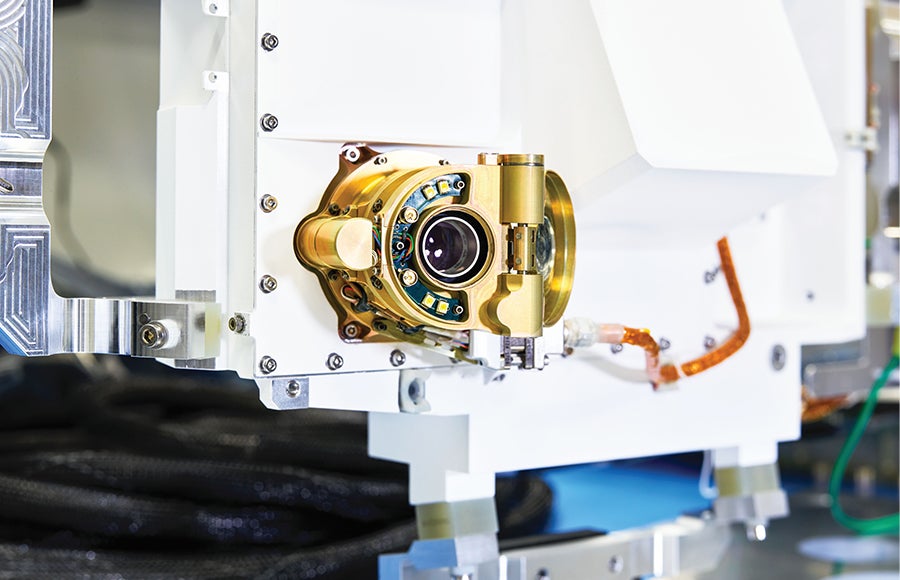
Mars rover Perseverance will look for signs of life backed by USC Dornsife research
Throughout much of 2020, observers in the Northern Hemisphere found themselves tracking the gas giants Jupiter and Saturn as they appeared to inch closer to one another each evening, culminating in a historic conjunction low in the southwestern sky a few days before Christmas.
But twinkling bright and amber, farther north and east, Mars awaited a more intimate encounter with a much smaller object — one made by human hands.
The Mars rover Perseverance, sent skyward on July 30, 2020, from Florida’s Cape Canaveral, hurtled through 300 million miles of space, reaching for the god of war’s namesake planet in arguably the most ambitious space mission to date.
On Feb. 18, Perseverance sets down in Jezero Crater, just north of Mars’ equator in the eastern hemisphere.
Aside from the historic helicopter, Ingenuity, designed to test powered flight in the Martian atmosphere, the robotic rover features a powerful system for detecting signs of life. Not the lumbering beasts or humanoids envisioned by a generation of science fiction authors, of course, but rather microscopic lifeforms akin to bacteria or algae found on Earth.
The Scanning Habitable Environments with Raman & Luminescence for Organics & Chemicals — more commonly known by its nerd-chic acronym “SHERLOC” — will search for subtle clues any microbes may have left behind.
SHERLOC uses technology developed under the direction of Professor Emeritus of Earth Sciences Ken Nealson at the USC Dornsife College of Letters, Arts and Sciences.
A renowned microbiologist and astrobiologist whose work includes the discovery of bacteria that live in extremely harsh conditions and can use rocks to breathe, Nealson worked to develop a component of SHERLOC called the deep ultra-violet microscope. The effort began in 1998, shortly after he became a senior scientist at NASA’s Jet Propulsion Laboratory and an adjunct professor at Caltech.
“My job was to set up a group in astrobiology, with a focus on life detection,” Nealson said.
One of the first people he hired was Rohit Bhartia, who would later earn a Ph.D. under Nealson’s mentorship at USC Dornsife. Early on, the duo settled on developing a microscopic imaging system that could function on Mars and readily identify complex molecules.

To accomplish this, the team needed a deep UV laser, which emits a tight beam of light that’s deep in the ultraviolet end of the spectrum.
Deep UV light has a shorter wavelength, enabling it to penetrate samples — including Martian soil and rocks — while causing organic molecules to glow with fluorescence. It has the added advantage of not stimulating the usual fluorescence of common minerals, which would cloud its ability to discern those organic molecules.
Today, SHERLOC’s deep UV laser is incredibly compact, but that wasn’t the case back in the late ’90s, when the research began.
“It required a large refrigeration system to cool the laser, which was huge … and required kilowatts of power — hardly the thing one might fly to Mars,” Nealson said.
But the team showed that the approach could work in principle, and by the time Nealson joined USC Dornsife in 2001, a much smaller deep UV laser that used far less power was available commercially.
A few years after that, “the entire system was the size of a large desk-top microscope and required only milliwatts of power,” he said, but still too large to fly to Mars.
Nealson and Bhartia continued work on the deep UV microscope for several years at USC Dornsife, working with a team that included Jan Amend, professor of Earth sciences and biological sciences, and Moh El-Naggar, Dean’s Professor of Physics and Astronomy and professor of physics and chemistry, as well as students and post-doctoral fellows. Their work showed that the microscope could be used to identify bacteria without having to use dyes to stain the cells. It could also be used on dry samples to distinguish many different molecules — a key necessity in the arid Martian environment.
Eventually, JPL engineers were able to make the deep UV microscope compact enough to mount on Perseverance’s robotic arm, where it is combined with other instrumentation that expands the number of chemicals the system can detect.
In what is the culmination of nearly 25 years of work on Nealson’s part, scientists will implement SHERLOC almost immediately after the rover touches down, aiming to learn about the types and amounts of organic and inorganic compounds on and just beneath the Martian surface. Should they detect possible chemical signatures of life, they can choose to bring samples back to Earth for deeper analysis.
Interestingly, Nealson says he argued to make certain SHERLOC’s instruments weren’t too sensitive because it might pick up trace chemicals, fooling scientists into believing a sample is more promising than it actually is.
“If there is or was life on Mars, it would be expected to be ‘housed’ in some kinds of cells, at high concentrations,” Nealson said, which means instruments with lower resolution and less sensitivity would detect these tiny, concentrated packets of life molecules while avoiding false-positive results. It is those samples, Nealson says, that are worth the long, complicated and expensive process of sending back to Earth so they can be examined for traces of life.
“I would hope that at low resolution, some very weak signals would tell us where to look with higher resolution, revealing the localization of organic matter in cell-like bodies,” he said. “That is my dream — to bring back those samples.”